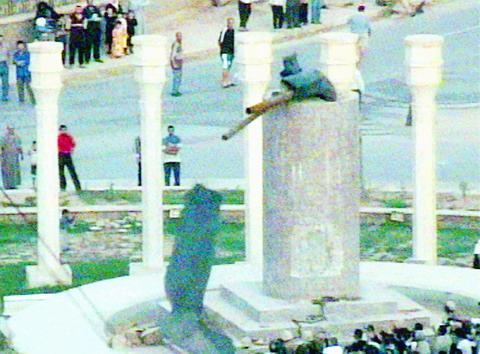US tanks and troops poured into the heart of Baghdad amid scenes of jubilation yesterday as Iraqi President Saddam Hussein's regime collapsed under a blistering three-week onslaught.
US forces met little Iraqi resistance as they took over swathes of the city, with looting erupting as it became clear that Saddam's 24-year stranglehold on the Iraqi people was disintegrating.
Tanks rolled into the heart of the city, with US soldiers helping jubilant Iraqis tear down a giant statue of Saddam in the Al-Fardus (Paradise) Square.

PHOTO: AP
They slung a thick rope noose around the Iraqi leader's neck, and controversially briefly draped the Stars and Stripes over his head.
Civilians queued up to hammer blow after blow into the plinth supporting the statue, while nearby soldiers chatted to journalists, the hatches of their tanks open, although other Marines on foot took up precautionary positions.
"The reception by the Iraqis was very warm and this was a big surprise to us. People are very nice," Staff Sergeant Daniel Attilio said.

PHOTO: REUTERS TV
US troops spread through the city to crush remaining pockets of resistance, facing snipers and isolated units prepared to make a last stand.
"Good, Good, Bush!" chanted cheering crowds in a northern district of Baghdad as a US Marine convoy passed by, as elsewhere angry crowds defaced and destroyed symbols of Saddam's regime.
US President George W. Bush was said by an administration official to be pleased with progress in the campaign, while Vice President Dick Cheney warned that "hard fighting" could lie ahead.
British Prime Minister Tony Blair, Washington's staunchest ally in the three-week-old war to wrench power from Saddam, warned: "This conflict is not, however, over yet."
Mystery still surrounds the fate of Saddam, who it is thought may try to make a last stand at his home-town of Tikrit north of Baghdad.
White House spokesman Ari Fleischer said Saddam had "missed his chance" to go peacefully into exile, hinting the administration believed the Iraqi leader still to be alive. "We still don't know his fate."
A spokesman for Blair said Iraq's command and control structure appeared to have broken down in Baghdad, adding that scenes of chaos and looting in the capital "tell their own story."
But he warned resistance to advancing US troops could still be quite "stubborn and fierce" after days of bloody fighting to wrest control of the capital of 5 million people, now largely deserted by pro-regime forces.
In the streets of Baghdad, people dared to utter the words "Traitor!" "Torturer!" "Dictator!" in reference to Saddam.
"We're ecstatic to get rid of him after all these years of war and deprivation," said Dinkha Khosina, joining hundreds of Iraqis to greet US troops racing from Baghdad's northern entrance to the heart of the capital.
"Welcome, welcome!" Baghdadis cried out in English, as young people took off their T-shirts and waved them in joy in front of the US soldiers.
"This is the greatest feeling I've had in my life, after spending 11 years in military service because of all the wars Saddam has put us through," said Ayub, who did not want his family name used.
In Saddam City, Baghdad's teeming Shiite suburb, people were seen breaking into shops and homes to steal furniture, food, electrical equipment and carpets.
In the north of the capital, citizens rampaged through the interior and irrigation ministries, gutting the offices, reporters said, while symbols of Saddam's iron grip on the country took the brunt of people's anger.
In other parts of the capital, Baghdadis tore up a giant portrait of Saddam, men brandished Kalashnikov rifles as they signalled their delight at the regime crumbling, while one white-haired man was seen laughing as he repeatedly hit at a poster of Saddam with a sandal.
City residents, hardened after almost 13 years of crippling economic sanctions, started looting symbols of Saddam's power, notably the irrigation and interior ministries and the headquarters of the Iraqi Olympic Committee, run by Saddam's elder son Uday.
US troops, moving up the eastern bank of the Tigris, approached the center of the capital, where they were expected to join units controlling the western side of the river, witnesses said.
Marines had seized Baghdad's eastern zone, though Iraqi snipers were still posing problems, a US military official said.
Allied warplanes still flew over the capital as smoke filled the skies, bringing air support to ground troops moving through the east and north of Baghdad where Iraqi forces had abandoned positions.
Dozens of Iraqi and Arab fighters in civilian clothing were still holed up behind buildings or in sandbagged positions on the western side of the Al-Jumhurya bridge spanning the river Tigris.
"Baghdad has not fallen and will never fall," said Mohammed al-Dahruj, a 24-year-old Syrian who volunteered to fight US-led forces.
At Sulaymaniya in the north of the country, streets erupted into a carnival atmosphere as tens of thousands of Kurds danced and sang at the news that US tanks controlled the center of Baghdad.
In southern Iraq, Basra was not yet totally under British control, Blair said.
"It is not secure for our troops yet, fully," he said. "[But it is] more under control today than it was yesterday."
Nothing has been heard from Saddam since a US bomber on Monday obliterated the building in Baghdad where he was believed to be with his two sons.
Major General Stanley McChrystal, with the US Joint Chiefs of Staff, said the air strike had been "very, very effective," but it was not known if the targets were still alive.
The Times of London said British intelligence believed Saddam had left the targeted building just before it was bombed.
The Washington Times quoted a US official as saying that US intelligence was "in a state of euphoria" because "there is no doubt he [Saddam] is dead."

TRAGEDY STRIKES TAIPEI: The suspect died after falling off a building after he threw smoke grenades into Taipei Main Station and went on a killing spree in Zhongshan A 27-year-old suspect allegedly threw smoke grenades in Taipei Main Station and then proceeded to Zhongshan MRT Station in a random killing spree that resulted in the death of the suspect and two other civilians, and seven injured, including one in critical condition, as of press time last night. The suspect, identified as a man surnamed Chang Wen (張文), allegedly began the attack at Taipei Main Station, the Taipei Fire Department said, adding that it received a report at 5:24pm that smoke grenades had been thrown in the station. One man in his 50s was rushed to hospital after a cardiac arrest

PUBLIC SAFETY: The premier said that security would be tightened in transport hubs, while President Lai commended the public for their bravery The government is to deploy more police, including rapid response units, in crowded public areas to ensure a swift response to any threats, President William Lai (賴清德) said yesterday after a knife attack killed three people and injured 11 in Taipei the previous day. Lai made the remarks following a briefing by the National Police Agency on the progress of the investigation, saying that the attack underscored the importance of cooperation in public security between the central and local governments. The attack unfolded in the early evening on Friday around Taipei Main Station’s M7 exit and later near the Taipei MRT’s Zhongshan

ON ALERT: Taiwan’s partners would issue warnings if China attempted to use Interpol to target Taiwanese, and the global body has mechanisms to prevent it, an official said China has stationed two to four people specializing in Taiwan affairs at its embassies in several democratic countries to monitor and harass Taiwanese, actions that the host nations would not tolerate, National Security Bureau (NSB) Director-General Tsai Ming-yen (蔡明彥) said yesterday. Tsai made the comments at a meeting of the legislature’s Foreign Affairs and National Defense Committee, which asked him and Minister of National Defense Wellington Koo (顧立雄) to report on potential conflicts in the Taiwan Strait and military preparedness. Democratic Progressive Party (DPP) Legislator Michelle Lin (林楚茵) expressed concern that Beijing has posted personnel from China’s Taiwan Affairs Office to its

SAFETY FIRST: Double the number of police were deployed at the Taipei Marathon, while other cities released plans to bolster public event safety Authorities across Taiwan have stepped up security measures ahead of Christmas and New Year events, following a knife and smoke bomb attack in Taipei on Friday that left four people dead and 11 injured. In a bid to prevent potential copycat incidents, police deployments have been expanded for large gatherings, transport hubs, and other crowded public spaces, according to official statements from police and city authorities. Taipei Mayor Chiang Wan-an (蔣萬安) said the city has “comprehensively raised security readiness” in crowded areas, increased police deployments with armed officers, and intensified patrols during weekends and nighttime hours. For large-scale events, security checkpoints and explosives